belt Alfa Romeo 8C 2009 Owner handbook (in English)
[x] Cancel search | Manufacturer: ALFA ROMEO, Model Year: 2009, Model line: 8C, Model: Alfa Romeo 8C 2009Pages: 223, PDF Size: 14.35 MB
Page 28 of 223
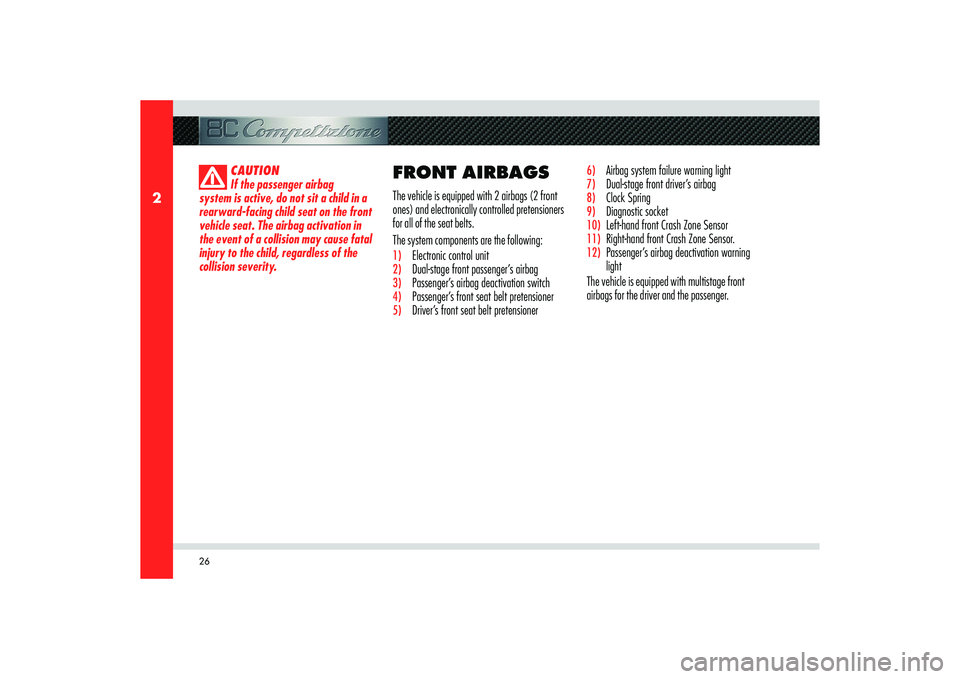
26
2
CAUTION
If the passenger airbag
system is active, do not sit a child in a
rearward-facing child seat on the front
vehicle seat. The airbag activation in
the event of a collision may cause fatal
injury to the child, regardless of the
collision severity.
FRONT AIRBAGSThe vehicle is equipped with 2 airbags (2 front
ones) and electronically controlled pretensioners
for all of the seat belts.
The system components are the following:1) Electronic control unit2) Dual-stage front passenger’s airbag 3) Passenger’s airbag deactivation switch4) Passenger’s front seat belt pretensioner5) Driver’s front seat belt pretensioner
6) Airbag system failure warning light7) Dual-stage front driver’s airbag8) Clock Spring9) Diagnostic socket10)
Left-hand front Crash Zone Sensor
11)
Right-hand front Crash Zone Sensor.
12)
Passenger’s airbag deactivation warning
light
The vehicle is equipped with multistage front
airbags for the driver and the passenger.
Page 30 of 223
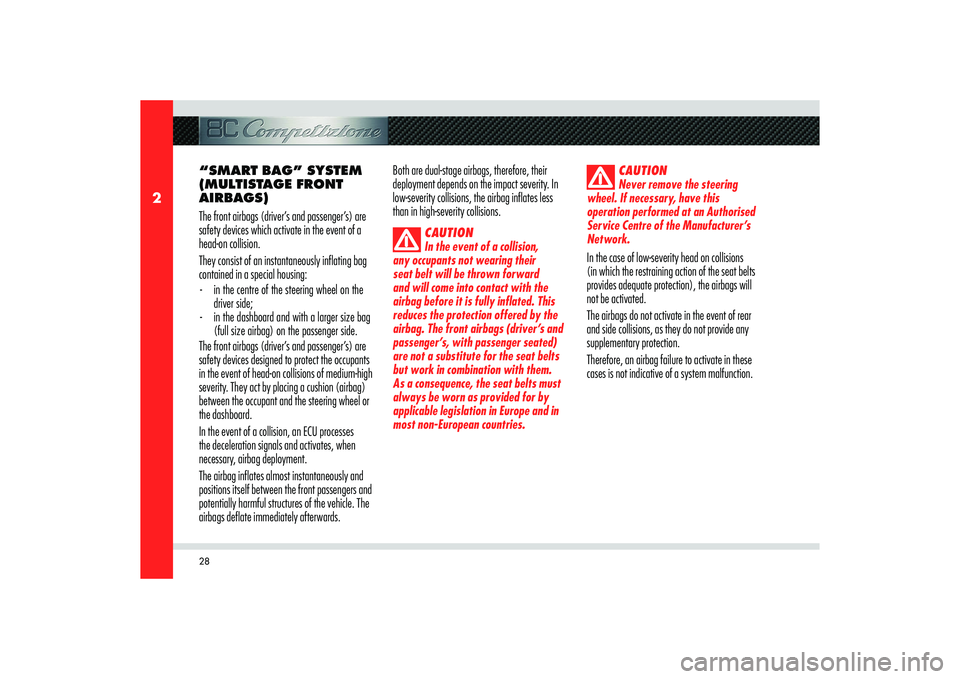
28
2
CAUTION
Never remove the steering
wheel. If necessary, have this
operation performed at an Authorised
Service Centre of the Manufacturer’s
Network.
In the case of low-severity head on collisions
(in which the restraining action of the seat belts
provides adequate protection), the airbags will
not be activated.
The airbags do not activate in the event of rear
and side collisions, as they do not provide any
supplementary protection.
Therefore, an airbag failure to activate in these
cases is not indicative of a system malfunction. “SMART BAG” SYSTEM
(MULTISTAGE FRONT
AIRBAGS)
The front airbags (driver’s and passenger’s) are
safety devices which activate in the event of a
head-on collision.
They consist of an instantaneously inflating bag
contained in a special housing:
- in the centre of the steering wheel on the
driver side;
- in the dashboard and with a larger size bag
(full size airbag) on the passenger side.
The front airbags (driver’s and passenger’s) are
safety devices designed to protect the occupants
in the event of head-on collisions of medium-high
severity. They act by placing a cushion (airbag)
between the occupant and the steering wheel or
the dashboard.
In the event of a collision, an ECU processes
the deceleration signals and activates, when
necessary, airbag deployment.
The airbag inflates almost instantaneously and
positions itself between the front passengers and
potentially harmful structures of the vehicle. The
airbags deflate immediately afterwards.Both are dual-stage airbags, therefore, their
deployment depends on the impact severity. In
low-severity collisions, the airbag inflates less
than in high-severity collisions.
CAUTION
In the event of a collision,
any occupants not wearing their
seat belt will be thrown forward
and will come into contact with the
airbag before it is fully inflated. This
reduces the protection offered by the
airbag. The front airbags (driver’s and
passenger’s, with passenger seated)
are not a substitute for the seat belts
but work in combination with them.
As a consequence, the seat belts must
always be worn as provided for by
applicable legislation in Europe and in
most non-European countries.
Page 31 of 223
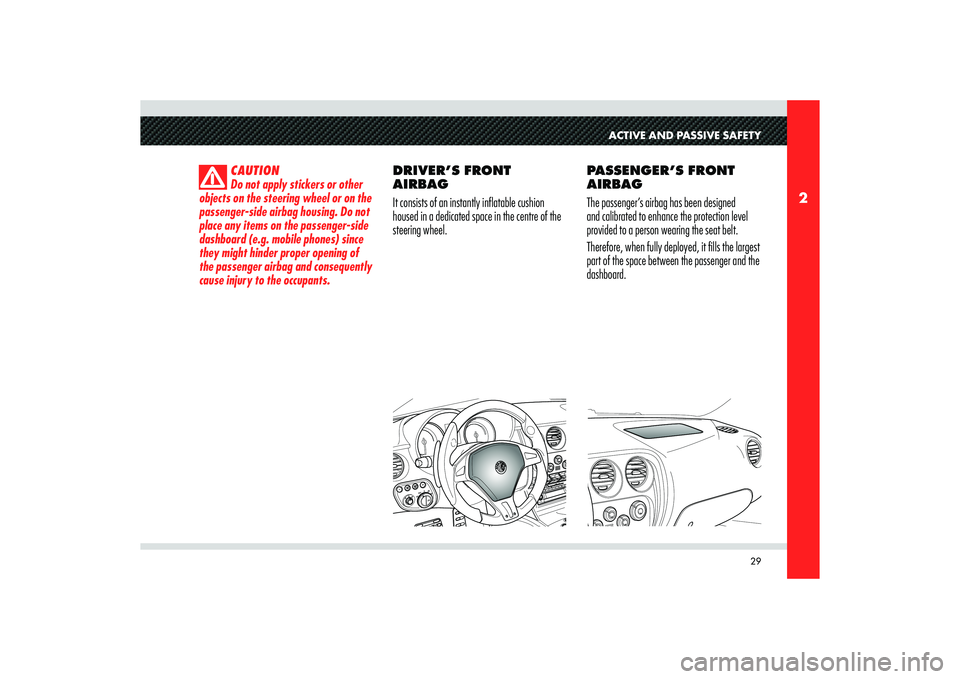
29
2
ACTIVE AND PASSIVE SAFETY
CAUTION
Do not apply stickers or other
objects on the steering wheel or on the
passenger-side airbag housing. Do not
place any items on the passenger-side
dashboard (e.g. mobile phones) since
they might hinder proper opening of
the passenger airbag and consequently
cause injury to the occupants.
DRIVER’S FRONT
AIRBAG
It consists of an instantly inflatable cushion
housed in a dedicated space in the centre of the
steering wheel.PASSENGER’S FRONT
AIRBAG
The passenger’s airbag has been designed
and calibrated to enhance the protection level
provided to a person wearing the seat belt.
Therefore, when fully deployed, it fills the largest
part of the space between the passenger and the
dashboard.
Page 33 of 223
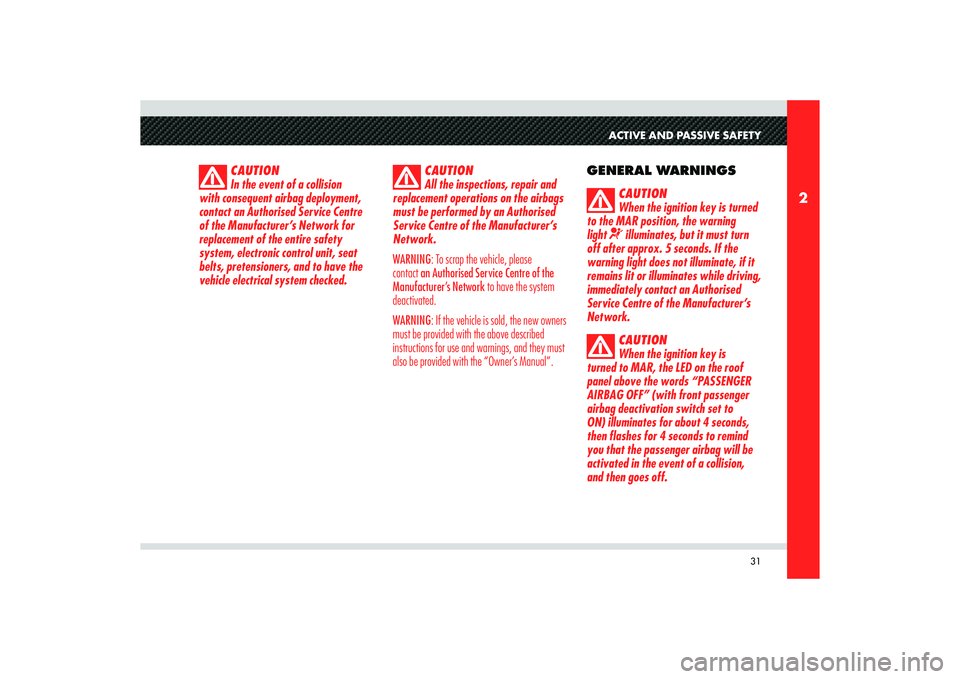
31
2
ACTIVE AND PASSIVE SAFETY
CAUTION
All the inspections, repair and
replacement operations on the airbags
must be performed by an Authorised
Service Centre of the Manufacturer’s
Network.
WARNING: To scrap the vehicle, please
contact an Authorised Service Centre of the
Manufacturer’s Network to have the system
deactivated.
WARNING: If the vehicle is sold, the new owners
must be provided with the above described
instructions for use and warnings, and they must
also be provided with the “Owner’s Manual”.
GENERAL WARNINGS
CAUTION
When the ignition key is turned
to the MAR position, the warning
light illuminates, but it must turn
off after approx. 5 seconds. If the
warning light does not illuminate, if it
remains lit or illuminates while driving,
immediately contact an Authorised
Service Centre of the Manufacturer’s
Network.
CAUTION
When the ignition key is
turned to MAR, the LED on the roof
panel above the words “PASSENGER
AIRBAG OFF” (with front passenger
airbag deactivation switch set to
ON) illuminates for about 4 seconds,
then flashes for 4 seconds to remind
you that the passenger airbag will be
activated in the event of a collision,
and then goes off.
CAUTION
In the event of a collision
with consequent airbag deployment,
contact an Authorised Service Centre
of the Manufacturer’s Network for
replacement of the entire safety
system, electronic control unit, seat
belts, pretensioners, and to have the
vehicle electrical system checked.
Page 34 of 223

32
2
CAUTION
Always drive keeping your
hands on the steering wheel so that, in
the case of activation, the airbag can
deploy without encountering obstacles
which may cause serious injuries. Do
not drive leaning forward, but keep
your seat back upright to support your
back.
CAUTION
To allow the front airbags to
deploy correctly and with optimal
efficiency, both the driver and the front
passenger must maintain a distance of
at least 25 cm from the steering wheel
and the dashboard.
CAUTION
Do not travel with objects in
your lap, in front of your chest or
holding a pipe, pencil or other object in
your mouth. In the event of a collision
with airbag deployment, these objects
may cause serious injuries.
CAUTION
Note that with the ignition
key inserted and turned to MAR,
even with the engine off, the airbags
may activate even if the vehicle is
stationary, if it is run into by another
vehicle. On the other hand, the airbags
will not activate in the event of a
collision with the vehicle stationary
and the key removed from the ignition
block: failure of the airbags to inflate
in these circumstances is not indicative
of system malfunction.CAUTION
If the vehicle has been subject
to theft or attempted theft, vandalism
or flooding, have the airbag system
checked at an Authorised Service
Centre of the Manufacturer’s Network.
CAUTION
If improper operations are
carried out on the electrical system,
the airbag could be activated, thereby
causing injuries to anyone in the
vicinity.
CAUTION
The airbags do not replace the
seat belts but provide supplementary
protection. Moreover, in the event of
head-on collisions at low speed, side
impacts, rear collisions or overturning,
the passengers are protected only by
the seat belts, which must always be
fastened.
Page 58 of 223
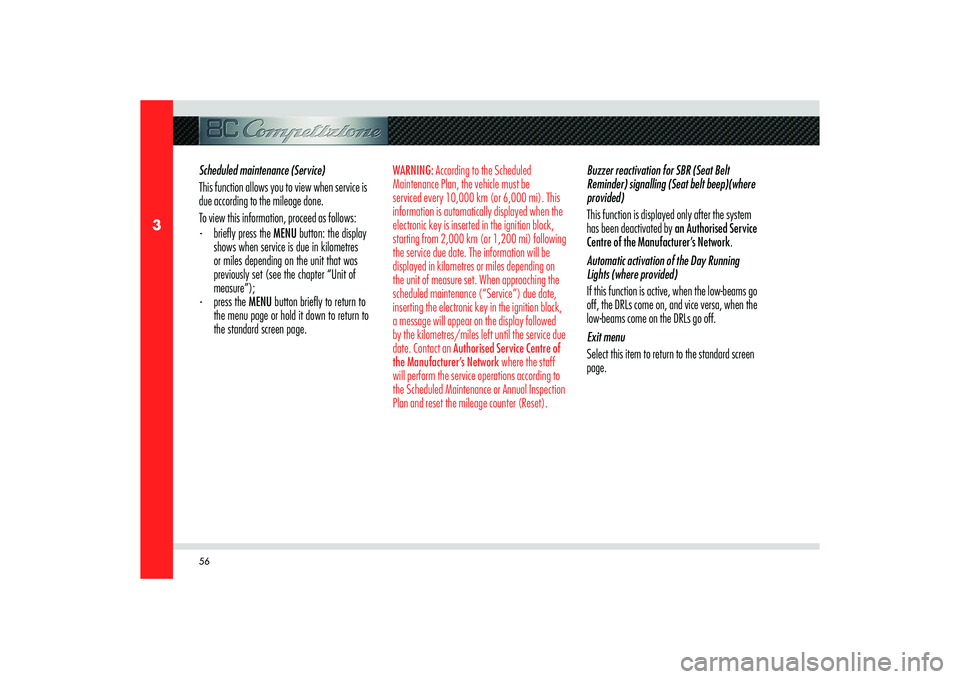
56
3
Scheduled maintenance (Service)
This function allows you to view when service is
due according to the mileage done.
To view this information, proceed as follows:
- briefl y press the MENU button: the display
shows when service is due in kilometres
or miles depending on the unit that was
previously set (see the chapter “Unit of
measure”);
- press the MENU button briefl y to return to
the menu page or hold it down to return to
the standard screen page.
WARNING: According to the Scheduled
Maintenance Plan, the vehicle must be
serviced every 10,000 km (or 6,000 mi). This
information is automatically displayed when the
electronic key is inserted in the ignition block,
starting from 2,000 km (or 1,200 mi) following
the service due date. The information will be
displayed in kilometres or miles depending on
the unit of measure set. When approaching the
scheduled maintenance (“Service”) due date,
inserting the electronic key in the ignition block,
a message will appear on the display followed
by the kilometres/miles left until the service due
date. Contact an Authorised Service Centre of
the Manufacturer’s Network where the staff
will perform the service operations according to
the Scheduled Maintenance or Annual Inspection
Plan and reset the mileage counter (Reset).
Buzzer reactivation for SBR (Seat Belt
Reminder) signalling (Seat belt beep)(where
provided)
This function is displayed only after the system
has been deactivated by an Authorised Service
Centre of the Manufacturer’s Network.
Automatic activation of the Day Running
Lights (where provided)
If this function is active, when the low-beams go
off, the DRLs come on, and vice versa, when the
low-beams come on the DRLs go off.
Exit menu
Select this item to return to the standard screen
page.
Page 64 of 223
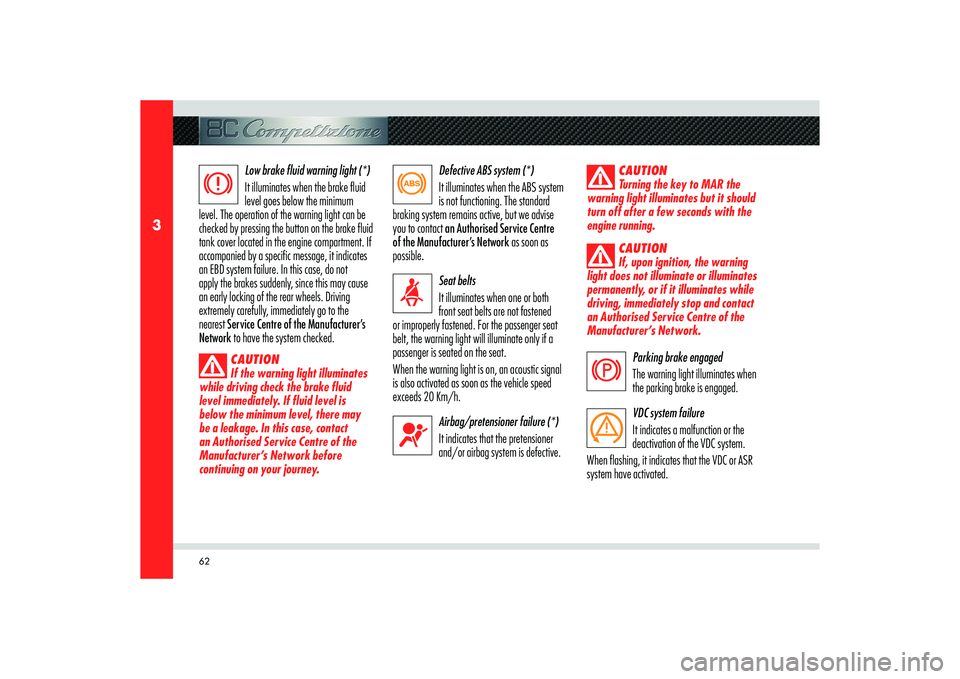
62
3
Low brake fluid warning light (*)
It illuminates when the brake fluid
level goes below the minimum
level. The operation of the warning light can be
checked by pressing the button on the brake fluid
tank cover located in the engine compartment. If
accompanied by a specific message, it indicates
an EBD system failure. In this case, do not
apply the brakes suddenly, since this may cause
an early locking of the rear wheels. Driving
extremely carefully, immediately go to the
nearest Service Centre of the Manufacturer’s
Network to have the system checked.
CAUTION
If the warning light illuminates
while driving check the brake fluid
level immediately. If fluid level is
below the minimum level, there may
be a leakage. In this case, contact
an Authorised Service Centre of the
Manufacturer’s Network before
continuing on your journey.
Defective ABS system (*)
It illuminates when the ABS system
is not functioning. The standard
braking system remains active, but we advise
you to contact an Authorised Service Centre
of the Manufacturer’s Network as soon as
possible.
Seat belts
It illuminates when one or both
front seat belts are not fastened
or improperly fastened. For the passenger seat
belt, the warning light will illuminate only if a
passenger is seated on the seat.
When the warning light is on, an acoustic signal
is also activated as soon as the vehicle speed
exceeds 20 Km/h.
Airbag/pretensioner failure (*)
It indicates that the pretensioner
and/or airbag system is defective.
CAUTION
Turning the key to MAR the
warning light illuminates but it should
turn off after a few seconds with the
engine running.
CAUTION
If, upon ignition, the warning
light does not illuminate or illuminates
permanently, or if it illuminates while
driving, immediately stop and contact
an Authorised Service Centre of the
Manufacturer’s Network.
Parking brake engaged
The warning light illuminates when
the parking brake is engaged.
VDC system failure
It indicates a malfunction or the
deactivation of the VDC system.
When flashing, it indicates that the VDC or ASR
system have activated.
Page 84 of 223
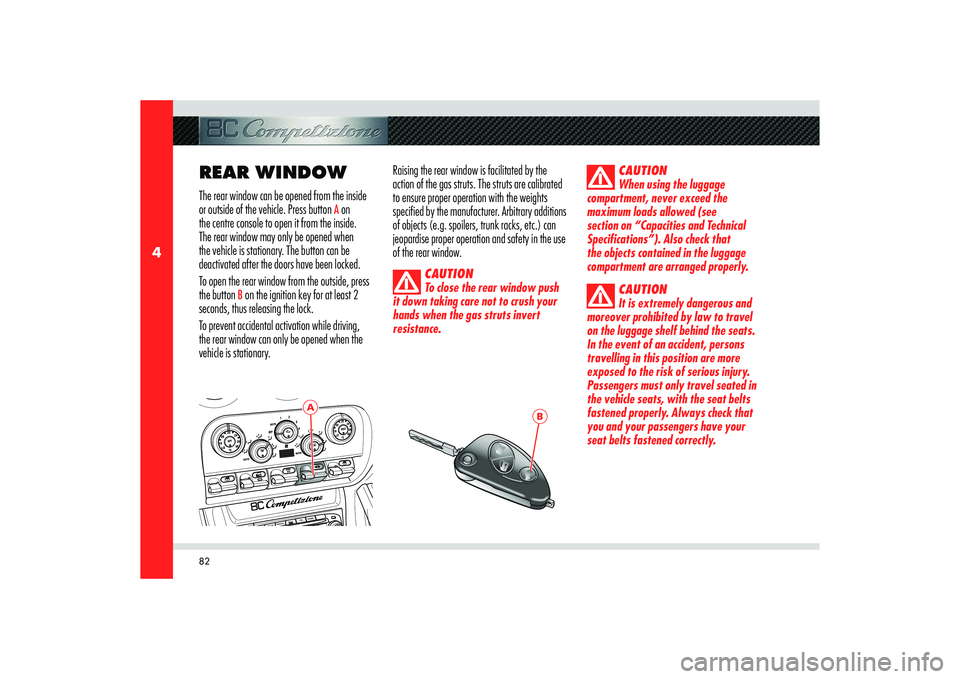
82
4
A
B
REAR WINDOWThe rear window can be opened from the inside
or outside of the vehicle. Press button
A on
the centre console to open it from the inside.
The rear window may only be opened when
the vehicle is stationary. The button can be
deactivated after the doors have been locked.
To open the rear window from the outside, press
the button
B on the ignition key for at least 2
seconds, thus releasing the lock.
To prevent accidental activation while driving,
the rear window can only be opened when the
vehicle is stationary.Raising the rear window is facilitated by the
action of the gas struts. The struts are calibrated
to ensure proper operation with the weights
specified by the manufacturer. Arbitrary additions
of objects (e.g. spoilers, trunk racks, etc.) can
jeopardise proper operation and safety in the use
of the rear window.
CAUTION
To close the rear window push
it down taking care not to crush your
hands when the gas struts invert
resistance.
CAUTION
When using the luggage
compartment, never exceed the
maximum loads allowed (see
section on “Capacities and Technical
Specifications”). Also check that
the objects contained in the luggage
compartment are arranged properly.
CAUTION
It is extremely dangerous and
moreover prohibited by law to travel
on the luggage shelf behind the seats.
In the event of an accident, persons
travelling in this position are more
exposed to the risk of serious injury.
Passengers must only travel seated in
the vehicle seats, with the seat belts
fastened properly. Always check that
you and your passengers have your
seat belts fastened correctly.
Page 94 of 223

92
4
A
B
A
B
FRONT SEATSThe seats are characterised by a wraparound
design (racing type) and have a carbon structure
and leather-covered seat.
CAUTION
It is extremely dangerous as
well has prohibited by law to travel
on the luggage shelf behind the seats.
In the event of an accident, persons
travelling in this position are more
exposed to the risk of serious injury.
Passengers must only travel seated in
the vehicle seats, with the seat belts
fastened properly. Always check that
you and your passengers have your
seat belts fastened correctly.
BACK/FORWARD
ADJUSTMENT
Pull the lever
A up and slide the seat forward or
backward to the desired position.
Release the lever and move the seat slightly to
ensure that it is locked in place.
We suggest that you move the seat fully back
before getting out of the vehicle, so that entering
and exiting the vehicle is more comfortable. SEATBACK INCLINATION
Lift lever
B and adjust the backrest to the desired
position; when the lever is released the backrest
will lock in this position.
The driver should never adjust the seat while
driving, as this may cause him to lose control of
the vehicle
Page 132 of 223

130
5
HEADLIGHTSBI-XENON HEADLIGHTS
The gas-discharge (Xenon) headlights use an
electric arc saturated with Xenon gas under
pressure, instead of the incandescent filament.
The light produced is markedly superior to that
of traditional light bulbs, in terms of quality
(brighter light) as well as of the span and
positioning of the area illuminated.
The advantages offered by better lighting can be
clearly perceived (less eye strain and increased
orientation for the driver and thus driving safety)
especially in the case of bad weather, fog
and/or insufficient road indications owing to the
broader illumination of the side zones, which are
normally left in the dark.The much broader illumination of the side zones
markedly increases driving safety as it allows the
driver to better detect other persons on the side
of the road (e.g. pedestrians, bicycle riders and
motorcycle drivers).
The electric arc requires very high voltage for
striking, but after activation power is supplied at
a lower voltage.
The headlights reach maximum brightness about
0.5 seconds after activation.
CAUTION
Should the bulbs need to
be replaced, have this operation
performed only at an Authorised
Service Centre of the Manufacturer’s
Network. RISK OF ELECTRICAL
SHOCKS!
DRIVING
CONDITIONSBEFORE A TRIP
Check the following at regular intervals and
always before long trips:
- tyre pressure and condition
- levels of fl uids and lubricants
- conditions of the windscreen wiper blades
- proper operation of the warning lights and
of the external lights.WARNING: It is always advisable to perform
these checks at least every 800 km and to
always follow the maintenance operations
provided for in the “Warranty and Maintenance
Schedule” book.It is also advisable to:
- clean the glass on the external lights and all
other glass surfaces
- properly adjust the mirrors, steering wheel,
seats and seat belts.